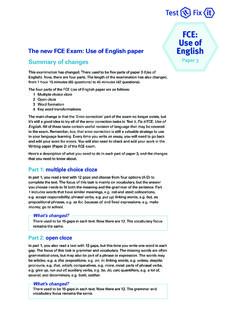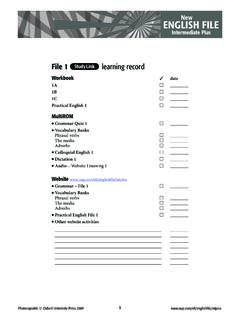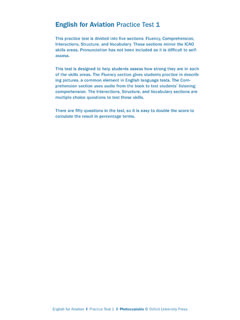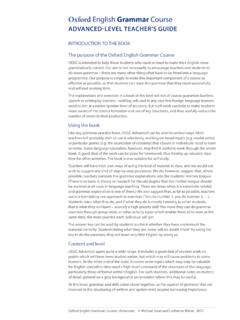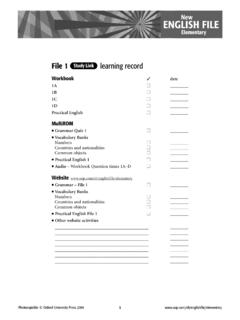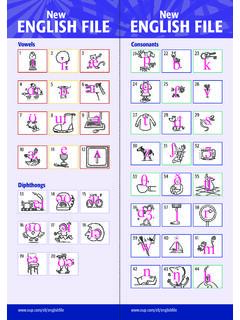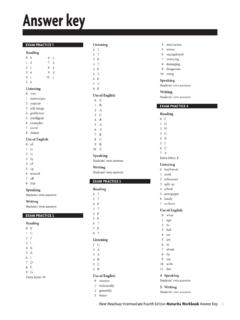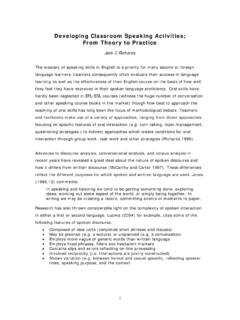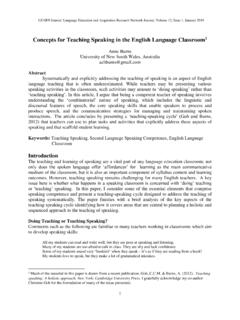Transcription of Speaking Tips - Oxford University Press
1 Speaking TipsTHE Oxford TEST OF ENGLISHIS CERTIFIED BY THEUNIVERSITY OF OXFORDS peaking TipsTips and practice for the Speaking module of the Oxford Test of English and Oxford Test of English for SchoolsOxford Test of English Speaking Tips Photocopiable Oxford University Press2 ContentsIntroduction 3 Test overview 4 The Speaking module 5 Tips for preparing for the Speaking module 6 part 1: Interview e 7 Exercise 1 Tip: Practise answering questions 1 and 2 e 7 Exercise 2 Tip: Listen carefully for the topic of each set e 8 Exercise 3 e 8 Exercise 4 9 Exercise 5 Tip: Give reasons for your answers e 9 Exercise 6 e 10 part 2: Voicemails 11 Exercise 1 Tip: Make sure you answer all three prompts e 11 Exercise 2 Tip: Try to use your own words e 13 Exercise 3 Tip: Try to expand your responses e 14 Exercise 4 14 Exercise 5 Tip: Use the right level of formality e 15 Exercise 6 e 16 Exercise 7 17 part 3: Talk e 18 Exercise 1 Tip: Make sure you answer the question e 20 Exercise 2 Tip: Organize your talk22 Exercise 3 22 Exercise 4 Tip: Give reasons for each point you make23 Exercise 5 e 24 Exercise 6 Tip: Use your preparation time e 25 Exercise 7 26 part 4: Follow-up questions 27 Exercise 1 Tip: Give reasons and examples e 27 Exercise 2 27 Exercise 3 Tip: Use a variety of phrases28 Exercise 4 28 Exercise 5 Tip.
2 Always try to answer a question e 29 Exercise 6 e 29 Speaking Tips at a glance 30 DOs and DON Ts for taking the Speaking module 32 Answer Key 33 part 1 e 33 part 2 34 part 3 36 part 4 39 Speaking Tips at a glance 40 DOs and DON Ts for taking the Speaking module 40 Oxford Test of English Speaking Tips Photocopiable Oxford University Press3 IntroductionOxford Test of English Speaking Tips is designed to help you maximize your result for the Speaking module of the Oxford Test of English and Oxford Test of English for Schools. There are four sections; one for each part of the test: Interview, Voicemails, Talk, and Follow-up section has advice (the tips ) on how to answer the questions in the test, exercises to help you put the tips into practice, and sample questions with audio that you can to use Oxford Test of English Speaking TipsOxford Test of English Speaking Tips is designed to be used for self-study or with a teacher in class.
3 Before you start using the tips, it s a good idea to take the online demo. This will show you what the test looks like, and give you an opportunity to practise interacting with the system. You can access the demos here: Oxford Test of English demoOxford Test of English for Schools demoSelf-studyIf you are using Oxford Test of English Speaking Tips for self-study, then work your way through each tip, completing the exercises and checking your answers in the Answer Key as you useIf you are a teacher using Oxford Test of English Speaking Tips with a class, you can work through each tip and exercise in order, and refer to the Answer Key for explanatory comments. Take every opportunity for students to work together and practise answering questions. Ideas to do this include students working: through the exercises collaboratively ( in pairs) through the exercises alone, and then comparing answers in pairs or groups in pairs; one asking questions, the other answering the questions in teams to create questions for other practiceFor further practice, the following books are available: Oxford Test of English B1 Practice TestsOxford Test of English B2 Practice TestsOxford Test of English Speaking Tips Photocopiable Oxford University Press4 Test overviewModulePartNo.
4 TasksNo. itemsStructureTimingSpeakingPart 126 (+ 2 unassessed)Interview: eight spoken questions on everyday topicsApprox. 15 minutesPart 222 Two voicemails with spoken and written inputPart 311A talk on an issue or scenario, with spoken and written input and picture promptsPart 416 Six spoken questions related to the theme of the part 3 talkListeningPart 155 Five discrete short monologues/dialogues with picture options, each with one questionApprox. 30 minutesPart 215A longer monologue with a note-completion taskPart 315A longer dialogue with a task focusing on identifying opinionsPart 455 Five discrete short monologues/dialogues with text options, each with one questionReading part 166 Six short texts from a variety of sources, each with one question35 minutesPart 216 Six texts, profiling people, are matched to four descriptionsORSix items are matched to three profiles of peoplePart 316 Six extracted sentences are inserted into a longer textPart 414A longer text with four questionsWriting part 111 Email (80 130 words)45 minutesPart 211 Essay (100 160 words)ORMagazine article or Review (100 160 words)The Oxford Test of English is for adult learners of English (aged 16 and over) at B2, B1, and A2 levels of the Common European Framework of Reference for Languages (CEFR)
5 And is certified by the University of Oxford . It tests your ability to communicate in English in a range of educational, professional, and social settings. The test takes approximately two Oxford Test of English is a computer-based test. It consists of four modules: Speaking , Listening, Reading, and Writing. You can take the whole test (all four modules), a single module, or any combination of the four modules. The test uses a bank of questions for each module so that during one test session, each test taker gets a different version of the test. The Listening and Reading modules are adaptive, which means that the questions get easier or more difficult depending on whether you answer them correctly or not. This allows the computer to accurately assess your level of English. The Speaking and Writing modules are marked by trained English language assessors. The Oxford Test of English for Schools is for 12- to 16-year-olds and is identical to the Oxford Test of English, except that the topics in the test are more suited to the age you take all four modules, you will receive a certificate.
6 If you take three modules or fewer, you will receive a module report card. The results can be used to show employers and universities your level of proficiency in English according to the CEFR levels. You can find a list of test centres where you can take the test at The certificate for Oxford Test of English and Oxford Test of English for Schools is the Test of English Speaking Tips Photocopiable Oxford University Press5 The Speaking modulePartStructureTesting focus1 Interview Eight questions on everyday topicsQuestions 1 and 2: Talk for ten seconds per questionQuestions 3 8: Talk for twenty seconds per question responding to questions giving factual information expressing personal opinions on everyday topics2 Voicemail Talk for forty seconds per voicemailTwenty seconds preparation timeVoicemail 1: Leave a voicemailVoicemail 2: Reply to a voicemail organizing longer speech Speaking formally, semi-formally or informally3 TalkShort talkChoose two of four photos to talk aboutThirty seconds preparation timeTalk for sixty seconds organizing longer speech describing comparing and contrasting speculating suggesting4 Follow-up questionsSix questions on the topic of the part 3 talkTalk for thirty seconds per questionAs for part 3 and including: responding to questions expressing, justifying, and responding to opinions expressing feelings agreeing and disagreeingDuring the testYou will need to wear the headphones provided during the Speaking module.
7 You will complete an audio check before the test starts to make sure the headphones and microphone provided by the test centre are working properly. You should speak clearly at a normal level into the microphone. You can change the volume during the test. During the Speaking module, other test takers in the room will be Speaking at the same time as you. There may also be some background noise, which the headphones will Speaking module has four parts: Interview, Voicemail, Talk, and Follow-up questions, and takes approximately 15 minutes. You will hear all the questions. The audio is played only once. For the Voicemails and Talk, the questions will also appear on the screen. Your answers to the questions are recorded. The recordings will be marked by a trained assessor, so please speak clearly into the microphone. For each question, a clock shows how much time you have to answer.
8 The Speaking module moves from one question to the next automatically. You cannot return to a question after the time runs more information about the test, make sure you check out Oxford Test of English: A Guide for Test Test of English Speaking Tips Photocopiable Oxford University Press6 Tips for preparing for the Speaking module1 Make a plan Find a study buddy another English learner who you can practise with. Make a weekly schedule of when you will Make sure you know what to expect Take the demo so that you know what it s like to take the test on a computer. Do practice tests so that you get used to the different kinds of questions in the Practise, practise, practise! Record yourself Speaking in English. Listen to the recording and think about how you could improve what you say, using a wider range of vocabulary and grammar, correcting your mistakes, Speaking more clearly.
9 Use a clock to time yourself answering the questions in the Speaking Tips. Keep doing this until you are comfortable talking for the same amount of time as you will be given to answer in the actual test. When you practise English, sometimes you should focus on Speaking fluently and not worry about making mistakes. At other times, you should focus more on using English correctly. Think of a lot of questions someone could ask you about yourself and write them down. Ask your study buddy to ask you the questions and practise answering them. Learn and practise words and phrases you can use when you leave a voicemail message, This is a message for .. Would it be possible to .. ? Learn and practise words and phrases you can use when you discuss something, I don t really agree with this. It seems to me that ..4 Use English whenever you can Always try to speak in English to your English teacher and to the other students in your English class.
10 Try to find people outside school who you can practise Speaking English with, relatives, friends, or tourists. Arrange to speak by telephone or over the Internet. Try watching films in English or with English subtitles. Listening to podcasts and audiobooks in English can help your Speaking . Try pausing the recordings and repeating sentences or parts of Test of English Speaking Tips Photocopiable Oxford University Press7 Speaking part 1: InterviewIn Speaking part 1, you will answer eight questions. You will hear the questions, but they will not show on the screen, so you need to listen carefully. Questions 1 and 2 are practice questions, so they are not assessed. These questions always ask you your name and which country you are from. Questions 3, 4 and 5 are a set about a particular topic, and you have 20 seconds to answer each question. Questions 6, 7 and 8 are another set about a different topic, and you have 20 seconds to answer each the interview questions are about you and your everyday are some examples of questions you might be asked in part What s your name?
